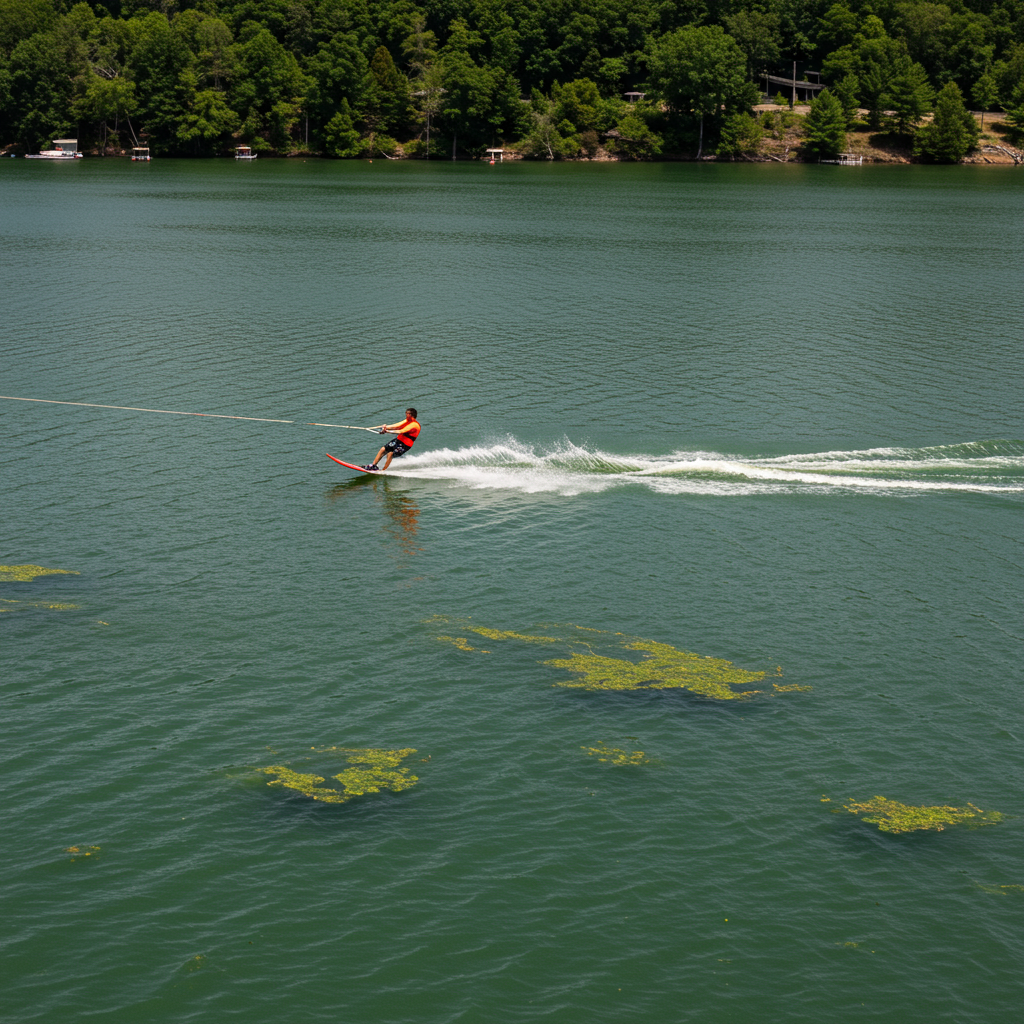A Missouri resident is battling a rare and often fatal brain infection, Primary Amebic Meningoencephalitis (PAM), suspected after waterskiing in the popular Lake of the Ozarks. Health officials have confirmed the presence of Naegleria fowleri, commonly known as the “brain-eating amoeba,” in this concerning case. The unidentified adult is currently in intensive care, highlighting the severe and rapid progression of this unique illness. While Naegleria fowleri infections are exceedingly rare, this recent incident serves as a critical reminder for anyone enjoying warm freshwater activities across the United States.
Understanding Naegleria Fowleri: The “Brain-Eating Amoeba”
Naegleria fowleri is a microscopic, single-celled amoeba naturally found in warm freshwater environments. These include lakes, rivers, ponds, hot springs, and even poorly maintained swimming pools. It thrives when water temperatures consistently exceed 77°F (25°C), typically during the summer months of July, August, and September. Despite its ominous nickname, this amoeba does not “eat” brains in the way one might imagine. Instead, it causes a devastating infection by destroying brain tissue.
Infection occurs when water containing the amoeba is forcefully pushed up a person’s nose. This commonly happens during activities like swimming, diving, or waterskiing. Once inside the nasal passages, the amoeba travels along the olfactory nerve to the brain. Crucially, swallowing water contaminated with Naegleria fowleri poses no risk, nor can the infection spread from person to person.
Despite the widespread presence of Naegleria fowleri in warm freshwater bodies, Primary Amebic Meningoencephalitis (PAM) remains incredibly rare. Data from the Centers for Disease Control and Prevention (CDC) shows only 167 reported PAM cases in the U.S. between 1962 and 2024. However, once contracted, the infection is almost universally fatal. This stark contrast between its rarity and its deadly outcome underscores the importance of public awareness and preventive measures.
The Missouri Case: A Recent Warning
The Missouri Department of Health and Senior Services (DHSS) confirmed the recent Naegleria fowleri infection in a Missouri resident. Preliminary information suggests a link to water-skiing at the Lake of the Ozarks, a popular vacation spot known for its vibrant water sports scene. While the exact source of exposure is still under investigation, the patient reportedly became ill days after their lake visit. Currently, health officials are not investigating other suspected cases in the area, but vigilance remains high. This case serves as a poignant reminder that even popular recreational areas can harbor such risks.
Recognizing the Rapid Warning Signs of PAM
The symptoms of Primary Amebic Meningoencephalitis (PAM) typically emerge about five days after exposure, though they can appear sooner or later. Initial signs often mimic other common illnesses, making early diagnosis challenging.
Early Symptoms:
Severe headache
Sudden fever
Nausea
Vomiting
As the infection progresses, the neurological symptoms become more pronounced and alarming. The disease advances rapidly, often leading to severe complications within days.
Advanced Symptoms:
Stiff neck
Confusion and disorientation
Hallucinations
Seizures
Coma
The progression from initial symptoms to severe neurological decline and death is alarmingly quick. Most infected individuals succumb to the illness within one to eighteen days after symptoms first appear, with the average survival time being just five days. Tammy Lundstrom, an infectious disease specialist, highlights that early symptoms should prompt immediate medical evaluation. They can easily be mistaken for bacterial meningitis, making prompt and accurate diagnosis critical for any chance of survival.
Crucial Prevention Strategies for Water Enthusiasts
Given the severe nature of PAM and the amoeba’s presence in warm freshwater, health officials strongly recommend taking precautions during water activities. These simple steps can significantly reduce the risk of infection.
Key Prevention Tips:
Nasal Protection: Always hold your nose shut, use nose clips, or keep your head above water when engaging in activities in warm freshwater, especially if jumping or diving. This prevents water containing the amoeba from entering the nasal passages.
Avoid Head Immersion: Limit or avoid putting your head underwater during summer activities in lakes, rivers, and ponds.
Minimize Sediment Disturbance: Naegleria fowleri often resides in the sediment at the bottom of freshwater bodies. Avoid digging or stirring up the bottom while swimming or wading.
Proper Nasal Rinsing: If you use neti pots or other devices for rinsing your sinuses, always use distilled, sterile, or previously boiled tap water. Never use untreated tap water for nasal rinsing.
Be Mindful of Water Temperature: The amoeba is most active when water temperatures are consistently warm. Exercise increased caution during peak summer months.
It is essential to remember that millions of people safely enjoy warm freshwater activities every summer. These precautions are aimed at minimizing an extremely rare but highly dangerous risk.
Treatment Challenges and Outlook
Treating Naegleria fowleri infections is incredibly challenging due to the rapid progression and high fatality rate of PAM. While a combination of antifungal medications and antibiotics has been used, their overall effectiveness in infected humans remains largely unknown. Common medications include amphotericin B, rifampin, and azithromycin. Miltefosine, a newer antifungal drug, has shown promise in laboratory tests against Naegleria fowleri and has been used to treat some of the rare surviving patients.
Despite these efforts, the grim reality is that survival from PAM is exceptionally rare. This underscores the importance of prevention and immediate medical attention if symptoms arise following warm freshwater exposure. Research continues into more effective treatments and faster diagnostic methods.
A Broader Perspective: Past Cases and Public Awareness
The Missouri case follows other tragic incidents across the U.S. Last month, 12-year-old Jaysen Carr died from a PAM infection after swimming in Lake Murray in South Carolina. His family has since spoken out, advocating for greater public awareness and prevention measures. These cases, while heartbreaking, serve to highlight the critical need for vigilance among public health agencies and recreational water users. Understanding the risks, even rare ones, empowers individuals to make informed decisions about their safety.
Frequently Asked Questions
What is Naegleria fowleri and how rare is the infection?
Naegleria fowleri is a microscopic, single-celled amoeba commonly found in warm freshwater. It causes Primary Amebic Meningoencephalitis (PAM), a severe and often fatal brain infection. While the amoeba is prevalent in warm water, human infection is extremely rare. According to the CDC, only 167 cases were reported in the United States between 1962 and 2024, making it one of the rarest but deadliest waterborne illnesses.
Which types of water are highest risk for Naegleria fowleri?
Naegleria fowleri thrives in warm freshwater environments. This includes lakes, rivers, ponds, and hot springs, especially when water temperatures are consistently above 77°F (25°C). It can also be found in poorly maintained swimming pools, splash pads, and unchlorinated tap water. Infection typically occurs when contaminated water enters the nose during water activities like swimming or diving.
What are the most effective ways to prevent Naegleria fowleri infection?
The most effective way to prevent Naegleria fowleri infection is to prevent water from entering the nasal passages. This includes holding your nose shut, using nose clips, or keeping your head above water when engaging in warm freshwater activities, especially if jumping or diving. Avoid stirring up sediment at the bottom of lakes or rivers, as the amoeba often resides there. For nasal rinsing, always use distilled, sterile, or previously boiled tap water.
Conclusion
The recent Naegleria fowleri case in Missouri, potentially linked to water-skiing at the Lake of the Ozarks, serves as a stark reminder of a rare but deadly freshwater risk. While Primary Amebic Meningoencephalitis (PAM) has an exceptionally high fatality rate, it’s crucial to remember the infection itself is extremely uncommon. Millions of people safely enjoy recreational water activities every year. By understanding the nature of Naegleria fowleri and implementing simple nasal protection measures, individuals can significantly reduce their risk. If you or someone you know experiences sudden headaches, fever, stiff neck, or vomiting after swimming in warm freshwater, seek immediate medical attention. Informed caution and swift action are key to navigating the minimal but serious threat posed by this “brain-eating amoeba.”


